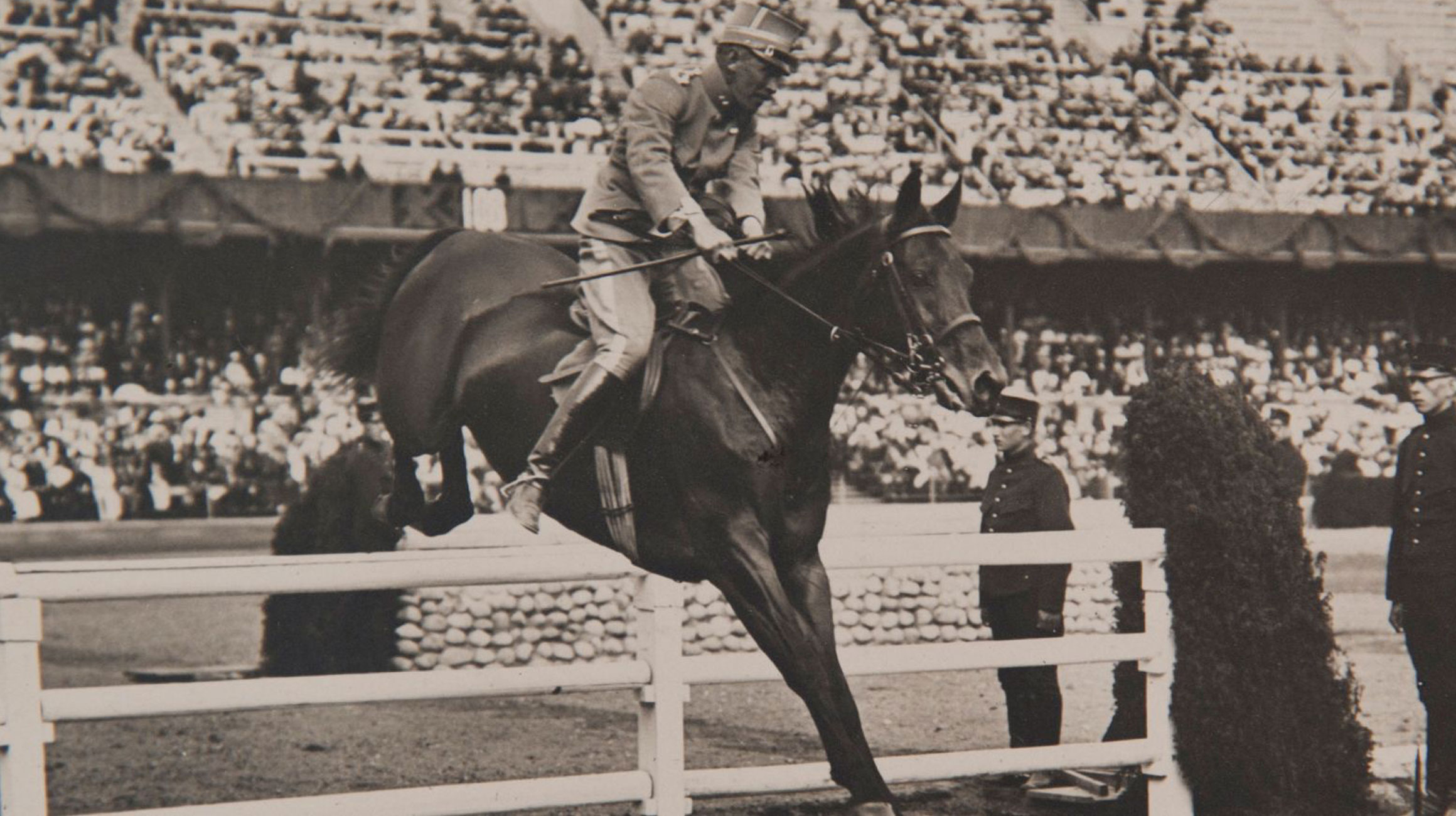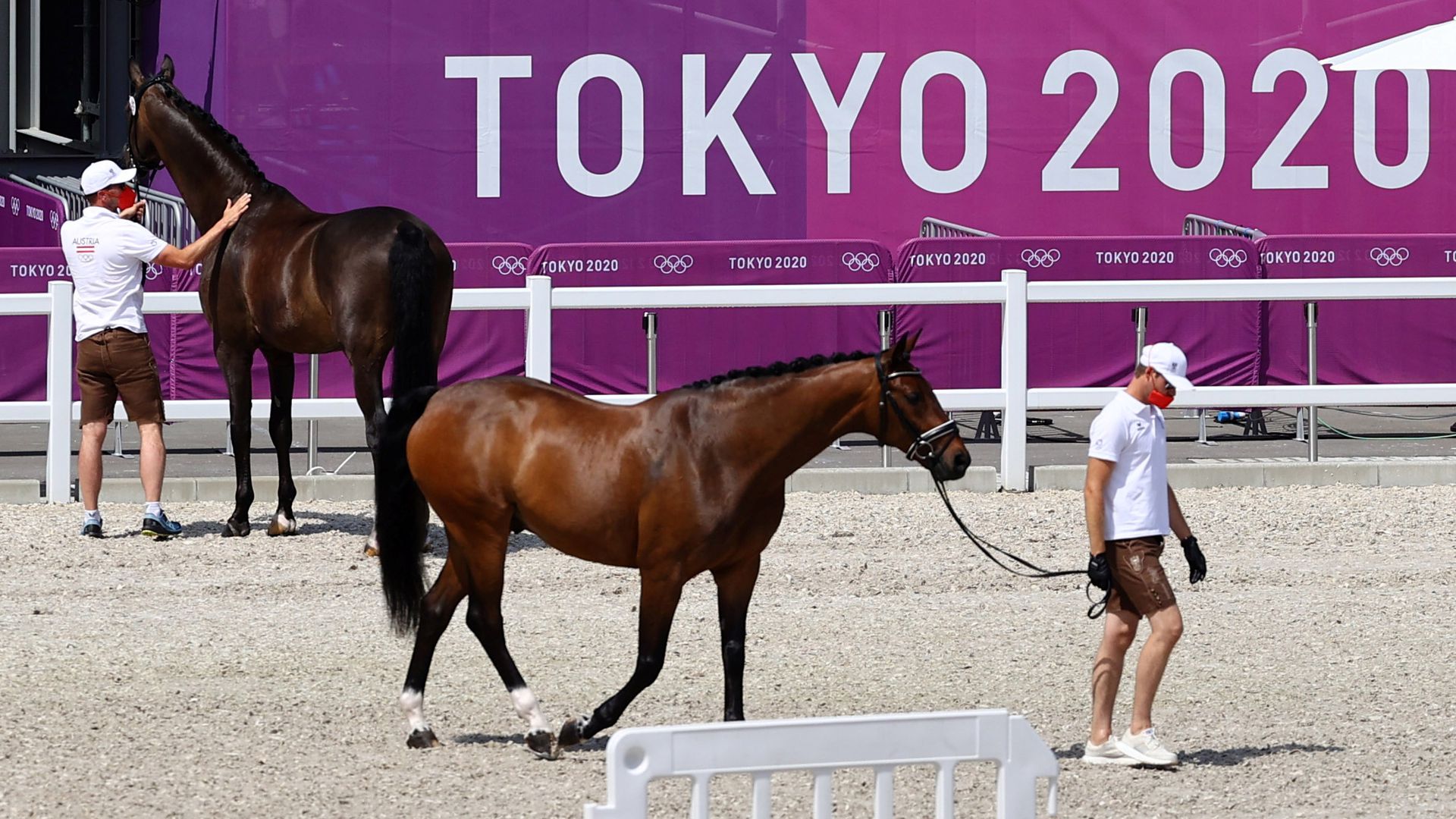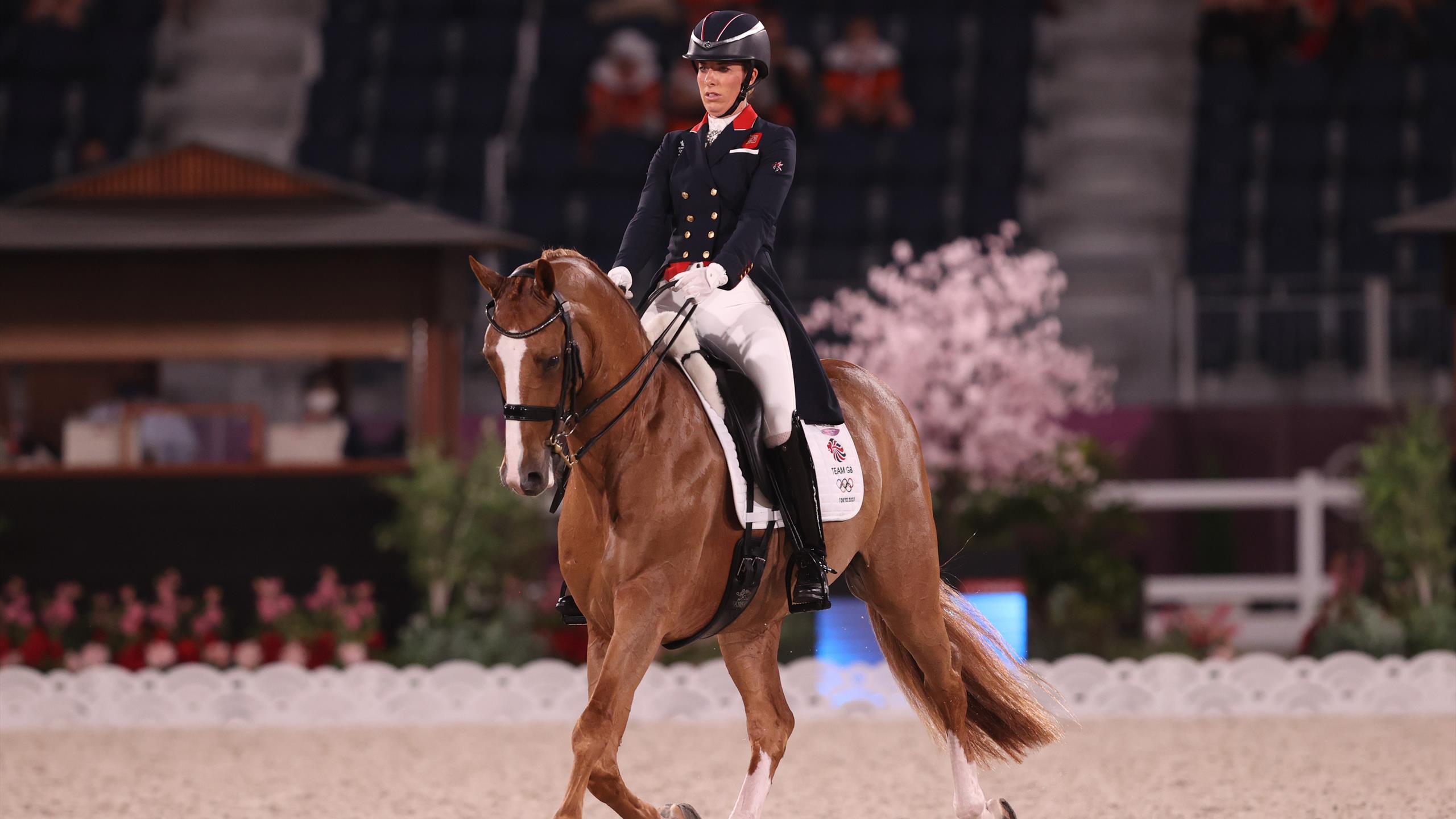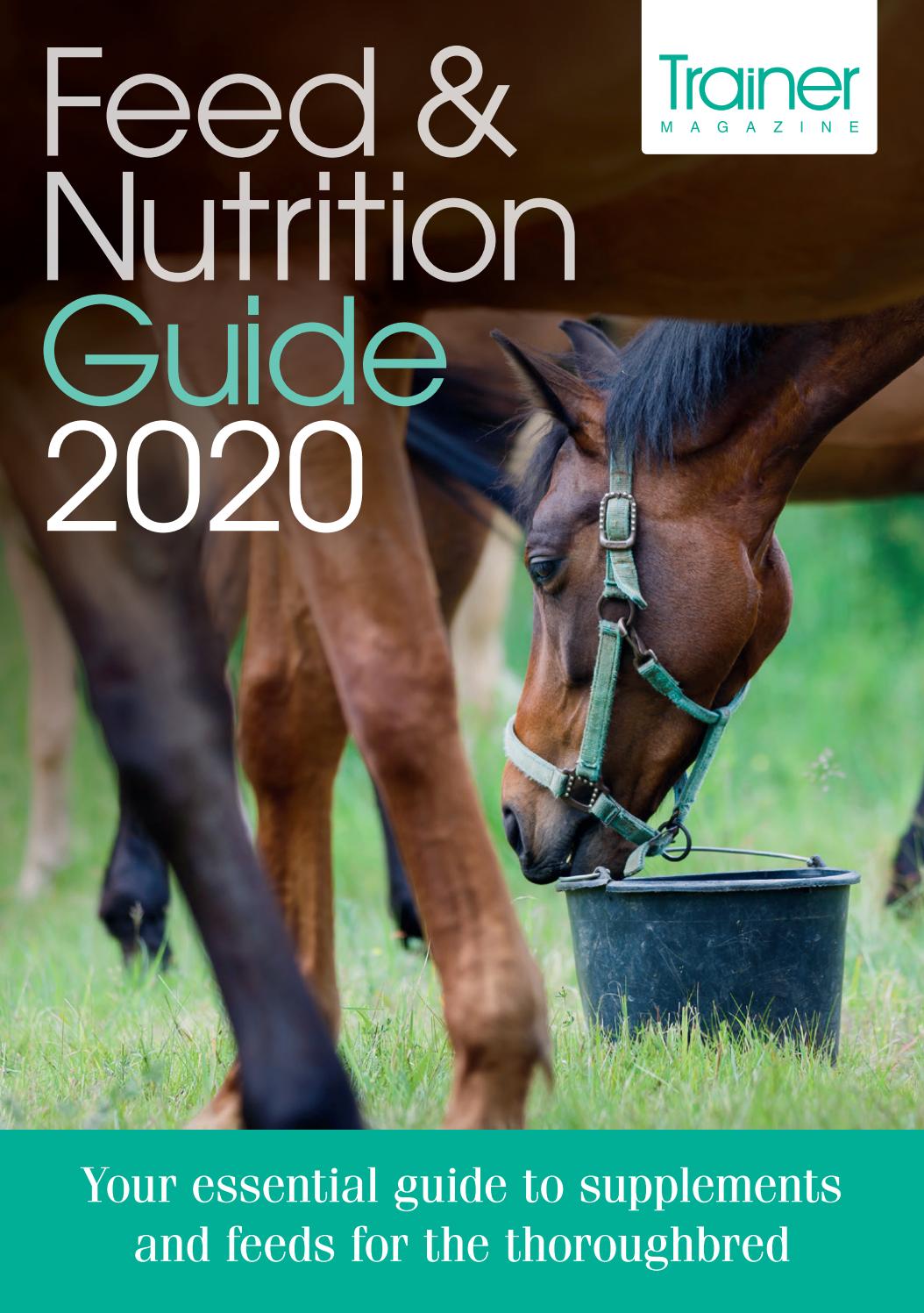The Olympics represents the pinnacle of achievement for human athletes, and this is no less true for the equestrian partners that compete alongside them. Identifying the breeds that excel in these games is essential for understanding the competition and the incredible partnership between horse and rider. In the world of Olympic equestrian sports, certain breeds stand out for their athleticism, intelligence, and suitability for the various equestrian disciplines horses are required to perform in. Here, we delve into the types of horses that grace the Olympic stages, their distinct characteristics, and what it takes to prepare these top equine athletes for the rigors of international competition.
Delving into the Premier Equine Breeds of Olympic Equestrian Competitions

At the apex of equestrian sports, a select group of horse breeds distinguishes themselves, each meticulously refined to meet the challenges of Olympic-level competition. We explore the individual traits and heritage of these preeminent breeds, shedding light on their selection by elite riders and their contribution to the majesty of Olympic equestrian events.
Discovering the Quintessential Dressage Equines
- Dutch Warmblood: Acclaimed for their fluid movements and competitive spirit.
- Hanoverian: Acknowledged for their steady temperament and graceful motion.
- Oldenburg: Recognized for their agility and ability to perform complex dressage figures.
The dressage contenders embody a synergy of agility and composure. The breeds that excel in dressage arenas demonstrate a unique combination of muscular strength, dexterity, and cognitive sharpness. Their pedigree often reflects a history of selective breeding aimed at perfecting the ultimate dressage competitor.
Highlighting the Elite Show Jumping Breeds
- Belgian Warmblood: Noted for their exceptional jumping form and courageous nature.
- Selle Français: Characterized by their agility and spirited competitiveness.
- Holsteiner: Applauded for their strong hind end and expansive jump.
In show jumping, equine contenders must display extraordinary courage and finesse to successfully complete intricate courses. These horses have undergone meticulous training and selective breeding to enhance traits conducive to agility and intrepidness.
Eventing Horse Breeds: All-Around Equestrian Champions
- Irish Sport Horse: Known for their cross-country expertise and tenacity.
- Thoroughbred: Prized for their stamina and vigor in rigorous contests.
- Warmblood Crosses: Preferred for their adaptability across eventing disciplines.
Eventing horses are heralded for their versatile capabilities in the equestrian realm. These breeds must showcase finesse in dressage, courage in cross-country, and meticulousness in show jumping, often boasting diverse lineage that enhances their comprehensive abilities.
These Olympic equestrian breeds are sculpted by the rigors of their respective sports, encompassing not only their physical prowess but also their mental fortitude. They are more than mere athletes; they are co-pursuers of Olympic distinction. An insight into their existence offers a deeper appreciation for the commitment and fervor that forge these remarkable horses into Olympic aspirants.
Understanding Olympic Horse Characteristics

Olympic equine athletes must possess a constellation of physical and mental traits to excel in the demanding arena of top-level equestrian events. These attributes are essential for their participation and potential success in the highly competitive Olympic environment. A thorough analysis reveals the specific qualities that epitomize an Olympic horse.
Physical Proficiency and Performance Indicators
The physical prowess of Olympic contenders is a critical factor for their performance. Vital characteristics that indicate a horse’s ability to succeed include:
- Structure: A balanced physique with a strong back, powerful haunches, and resilient limbs sets the foundation for athletic capability.
- Endurance: Sustained performance throughout an event reflects a horse’s stamina and durability.
- Precision: The capacity for detailed and adept course navigation is essential for Olympic disciplines.
- Movement: Effective and rhythmic strides are crucial for speed and ground coverage.
- Adaptability: Prompt and adept reactions allow for swift adjustments to the varying demands of Olympic courses.
- Learning Ability: The willingness to acquire and apply new skills is vital for ongoing development in the Olympic arena.
Such performance skills are refined through dedicated training, preparing each horse for the high-pressure competition they will encounter.
Cognitive and Behavioral Attributes
The mental makeup of an Olympic horse is equally as important as its physical attributes. Essential cognitive and behavioral traits encompass:
- Attention: The ability to stay focused is imperative to avoid mistakes.
- Eagerness: A horse’s enthusiasm for collaboration enhances the partnership with its rider.
- Equanimity: Staying poised in the face of intense competition is a key trait for success.
These mental characteristics are nurtured to foster a cohesive relationship between horse and rider, pivotal for Olympic triumphs.
Preparation for Optimal Performance
To achieve their best in the Olympic ring, horses must be in exemplary condition. This is achieved through:
- Diverse Training: An elaborate and methodical training regimen is essential for maintaining fitness and expertise.
- Veterinary Care: Proactive health maintenance helps to avert possible medical concerns.
- Protective Measures: Careful attention to the horse’s physical well-being helps prevent injuries.
- Rest Protocols: Recovery strategies are crucial for the animal’s career longevity and well-being.
Such meticulous preparation is fundamental to readying Olympic horses for the demanding nature of their events.
Emotional Acumen and Responsiveness
The emotional acuity of Olympic horses plays a pivotal role in their competitive performance. A profound rapport with their handlers can significantly influence their responsiveness and adaptability in high-pressure situations. The emotional connection shared between horse and rider can be a significant factor in their competitive success.
Conclusion
In summary, the distinctive blend of innate ability and strategic development is what shapes an Olympic horse into an exceptional athlete. These horses embody the result of a rigorous and targeted approach to their training, care, and competitive engagement. Grasping the spectrum of these characteristics sheds light on the elements that contribute to an Olympic horse’s journey from a mere contender to a distinguished competitor in the equestrian domain.
Warmblood Horses: The Epitome of Equestrian Excellence in Olympic Sports

The Olympic equestrian landscape is graced by the prowess and elegance of Warmblood horses, a group of breeds renowned for their competitive edge. These equine athletes are distinguished by a harmonious blend of strength, grace, and intelligence, making them the preferred choice for competitors at the Olympic level. The term ‘Warmblood’ refers to various breeds that have been selectively honed for excellence in the uppermost tiers of equestrian sport, reflecting their exceptional abilities and the breeding practices that have optimized their innate talents.
Warmbloods: Synonymous with Olympic Success
At the core of equestrian distinction, Warmbloods exhibit traits that render them particularly suited for the Olympic stage:
- Composure: Their stable yet attentive demeanor allows them to thrive amidst the excitement of the Olympics.
- Physical Capability: Their well-proportioned form is a testament to their inherent sportive qualities, balancing power with nimbleness.
- Willingness to Learn: Their desire to be trained and capacity to adapt make them invaluable companions for riders with Olympic aspirations.
Warmblood Standouts in Olympic Disciplines
Several Warmblood breeds have consistently demonstrated their aptitude in Olympic events:
- Dutch Warmblood: Their adaptability allows them to excel in both dressage and show jumping at elite levels.
- Swedish Warmblood: With a heritage rich in dressage, they exhibit poise and dedication.
- Westphalian: Renowned for their competitive edge, this breed has produced many international champions in show jumping and dressage.
Refining Warmblood Breeding for Optimal Olympic Performance
Breeding programs for Warmbloods have been meticulously developed to yield horses capable of not only meeting the physical challenges of Olympic sports but also demonstrating mental prowess under competitive pressures. This evolution in breeding is characterized by a comprehensive evaluation of traits, such as physical conformation and temperament, to produce progeny of the highest caliber. Innovations in genetic science have fine-tuned these practices, enhancing the predictability of Olympic-level prospects.
- Intentional Breeding Choices: Breeders strategically select pairings that amalgamate superior qualities from both parents to advance the bloodline.
- Rigorous Aptitude Assessments: Prospective Warmbloods are subjected to extensive testing to ascertain their compatibility with the demands of Olympic disciplines.
- Cross-Border Bloodlines: To augment the genetic pool and perfect athletic characteristics, breeders incorporate international pedigrees.
Customized Training for Warmblood Olympic Contenders
Warmblood horses in Olympics benefit from bespoke training programs that play to their strengths and address areas for improvement. These programs meld classical equestrian principles with contemporary techniques to bring out the best in each horse. Psychological training is also essential, ensuring these Warmbloods remain attentive and calm, even in the high-stakes environment of Olympic contests.
Warmbloods: A Legacy of Olympic Equestrian Achievements
Warmblood breeds have not only shaped the Olympic equestrian scene but have also profoundly influenced the broader equestrian community. Their accomplishments are lauded both in international events and in breeding circles, establishing benchmarks for equestrian prowess. The synergy of exceptional genetics, conscientious training, and insightful breeding has positioned Warmbloods as the embodiment of equine agility and elegance at the Olympics.
As symbols of versatility and skill, Warmblood horses continue to anchor the Olympic equestrian experience, enchanting spectators across the globe with their performances. Bolstered by the collective efforts of breeders, trainers, and riders, the legacy of these horses within the Olympic realm is poised to flourish well into the future.
Thoroughbreds: A Multifaceted Presence in Olympic Equestrian Sports

Thoroughbreds have carved a niche in Olympic equestrianism, bringing their unique qualities from racetracks to the multifaceted world of eventing. This breed’s journey to the Olympics is a testament to their versatility and illustrates the range of their capabilities in different disciplines.
Thoroughbred Versatility Beyond Racing
As eventing specialists, Thoroughbreds leverage their innate speed and stamina, transitioning from racing to performing in a triathlon of equestrian disciplines. Their intelligence and strong work ethic are enhanced through targeted training, equipping them for the diverse challenges of eventing at the Olympic level.
Thoroughbred Strengths in Eventing
- Speed: Their quickness is a boon in the cross-country phase of eventing.
- Endurance: Stamina is a Thoroughbred hallmark, pivotal for enduring the demands of long courses.
- Agility: Thoroughbreds demonstrate natural athleticism, essential for eventing’s varied challenges.
Specialized Training for Olympic Aspirations
Training regimens for Olympic Thoroughbreds emphasize preserving racing traits while fostering skills for dressage precision and show jumping finesse. This well-rounded approach prepares them to face a spectrum of equine athletes in Olympic competition.
Thoroughbred Impact in Dressage and Show Jumping
In dressage, Thoroughbreds can be taught to perform intricate movements with grace, while in show jumping, their boldness and light-footedness are assets. Riders who synchronize with their Thoroughbred partners can excel in these disciplines.
Thoroughbred Olympic Role Models
Examining the narratives of Thoroughbreds that have excelled in the Olympics provides insight into effective training and the harmonious partnerships necessary for high-level competition.
Second Careers and Reshaping Lives
Retired racers often find renewed purpose in equestrian sports, where their versatility shines. Transition programs play a crucial role in acclimating Thoroughbreds to new equestrian roles, showcasing their adaptability and enduring spirit.
Emphasizing Thoroughbred Aftercare
The equestrian community prioritizes the well-being of Thoroughbreds post-competition. Aftercare initiatives ensure these horses receive the care and opportunities to enjoy their retirement or engage in alternate equestrian activities.
Thoroughbreds’ Prospects in Olympic Equestrianism
The future for Thoroughbreds in Olympic equestrian sports looks bright as the community continues to harness and evolve their racing prowess for success in the Olympic arena.
The legacy of Thoroughbreds in Olympic equestrian events speaks to their remarkable adaptability and the concerted efforts to harness their racing heritage for diverse equestrian disciplines. Their ongoing contributions to equestrian sports are a testament to their enduring value and the dedication of those who guide their transition from the racetrack to the Olympic stage.
International Competition Horse Breeds: A Mosaic of Top Equine Athletes

The splendor of global equestrian competitions, especially the Olympics, highlights the extraordinary capabilities of equines that have been selectively honed for such illustrious events. A close examination of this elite assemblage reveals the intricate details that distinguish these accomplished breeds and the methods employed to cultivate their exceptional abilities.
Assortment and Excellence Among Olympic Equines
Diverse breeds present at international competitions bring specific advantages to their disciplines. Observers marvel at the prowess of Warmbloods in elaborate maneuvers and the endurance of crossbreeds in multi-phase events. This spectrum of talent reflects the inclusive nature of the sport and the breadth of equine skill that contends for Olympic distinction.
Intentional Breeding for Top-Tier Performance
The calculated art of breeding shapes the physical and mental aspects of these elite horses. Selective pairing, grounded in an understanding of equine genetics, aims to produce offspring capable of meeting the Olympic standards of their respective sports. The process involves:
- Lineage Analysis: Careful consideration of a horse’s heritage to identify predispositions beneficial for certain equestrian challenges.
- Conformation Selection: Emphasis on optimal physical attributes that correlate with the agility and endurance necessary for Olympic disciplines.
- Performance Evaluation: Scrutiny of both the individual’s and its relatives’ competitive accomplishments as a forecast of potential prowess.
Genetic Contributions to Equine Distinction
Genetic research plays a significant role in advancing the breeding of horses for international competition. By pinpointing and propagating the genetic markers associated with preferred characteristics, scientists and breeders collaborate to develop horses that are not only physically adept but also possess the cognitive resilience needed for Olympic challenges.
Worldwide Breeding Collaborations
Breeders frequently incorporate global genetic lines to enrich their breeding programs, thereby creating horses that represent the pinnacle of international traits. This broad approach to breeding contributes to a more diverse and potentially superior progeny.
- International Genetic Enrichment: The exchange of superior breeding stock with international partners to introduce beneficial qualities.
- Comprehensive Pedigree Documentation: Accurate recording of lineage and achievements is indispensable for informed breeding choices.
Nurturing Prospective Olympic Equines
Preparation for top-level competition starts from a young age, with careful cultivation of a horse’s natural aptitudes. Foundational training and incremental exposure to competitive scenarios are key to preparing young equines for the pressures and demands of international events.
- Basic Training Regimen: Early training establishes the essentials for further skill development.
- Introduction to Competitive Settings: Participating in initial competitive experiences helps young horses become accustomed to the environment of high-stakes events.
From the esteemed Warmbloods to the resilient Thoroughbreds, the rich variety of international competition horse breeds embodies the deep specialization and heritage within the equestrian community. Their cultivation demands an integration of time-honored equestrian practices with contemporary genetic insights, all in pursuit of equine excellence on the grand international stage.
Advancing Olympic Equine Athletes with Cutting-Edge Training

To propel Olympic equine athletes towards victory, a sophisticated blend of cutting-edge training methods is crucial. Tailoring training to each horse’s distinctive abilities, coaches and riders collaborate to pioneer training regimens that sharpen the horse’s skill set. These regimens often integrate cross-training to boost the horse’s versatility, mental agility, and overall balance, specifically aligning with the demands of their particular equestrian discipline.
Comprehensive Training Techniques
An Olympic horse’s training program is characterized by its comprehensiveness, which can include:
- Aquatic exercises such as swimming to build stamina while minimizing joint stress.
- Gymnastic routines that enhance coordination and flexibility.
- Cavaletti training to perfect stride control and timing.
Discipline-Specific Skill Enhancement
Specialized exercises are fundamental for honing the skills required by each equestrian discipline. For example, dressage competitors may repeatedly practice complex movements to ensure precision, whereas show jumpers might engage in drills that boost their obstacle navigation skills.
Advancing Equine Health and Nutritional Well-being for Premier Competition
The foundation of an Olympic equine’s athletic capability is a rigorous focus on health and nutritional well-being. Customized dietary plans are scrupulously designed to match the horse’s energy requirements and training demands, with adjustments made as competitions draw near to maximize performance levels.
Customized Nutritional Programs
Personalized feeding regimens for Olympic equines often consist of:
- Top-grade forage to promote stable energy levels and gastrointestinal health.
- Energy-rich feeds that are calibrated to the horse’s workload and condition.
- Targeted supplements to correct any specific nutrient gaps or deficits.
Preventive Health Strategies
A proactive stance on health maintenance is key to the success of Olympic equines. This includes routine veterinary oversight and preventative care measures such as:
- Consistent hoof maintenance to guarantee optimal foot condition and functionality.
- Evaluations of the horse’s musculoskeletal system to preempt injuries.
- Complementary therapies that may encompass treatments like chiropractic care or acupuncture to maintain overall health.
Critical Recovery and Rehabilitation Practices for Olympic Equines
Recovery and rehabilitation are integral to an Olympic equine’s regimen, ensuring that the horse’s muscles recuperate and adapt post-training. This involves structured cooldowns, designated rest periods to thwart overtraining, and employing therapeutic methods such as massage or cold compression to foster muscle repair and mitigate inflammation.
Strategies for Rest and Recuperation
To sustain an Olympic horse in prime physical shape, rest and relaxation strategies are employed, including:
- Controlled turnout areas to promote stress relief and unhindered movement.
- Ensuring restorative sleep in conducive stable environments for optimal recovery and mental well-being.
- Adapting training schedules to intersperse lighter activities after strenuous sessions.
Focused Injury Prevention and Care
Olympic trainers emphasize injury prevention through:
- Regular check-ups to recognize and address early signs of strain or injury.
- Protective equipment utilization during training and events to prevent harm.
- Reinforcement exercises designed to fortify areas vulnerable to injury.
By harmonizing state-of-the-art training, nutrition, and health care practices, Olympic equine athletes are primed for peak performance. The commitment to their comprehensive development underscores the quest for equestrian excellence on the Olympic stage.
Frequently Asked Questions About Olympic Equestrian Horses
Interest in the nuances of Olympic equestrian horses is widespread among spectators and aficionados. We tackle some of the inquiries frequently posed about these distinguished equine competitors.
Choosing Horses for Olympic Glory
The intricate process of selecting horses for the Olympics involves assessing their qualifications, health, and psychological readiness. This is often undertaken by national equestrian federations and their committees, focusing on aspects such as:
- Performance in qualifiers and overall consistency.
- Health evaluations conducted by veterinarians.
- Mental composure in high-pressure environments.
Ensuring Longevity in Olympic Equine Competitors
Olympic equine athletes can enjoy extended careers, influenced by:
- Hereditary Factors: Genetic predispositions may impact lifespan.
- Management: Quality care and stewardship practices.
- Workload: The intensity and regularity of training and competing.
With a harmonious combination of these factors, these horses often have prolonged athletic careers.
The Spectrum of Breeds in Olympic Equestrianism
Though certain breeds might have historical prevalence, Olympic equestrian sports welcome a variety of breeds. Success in competition can be influenced by:
- Athletic aptitude and tailored training regimens.
- Rider compatibility, fostering a synchronized partnership.
- Resilience in the distinctive Olympic environment.
Comprehensive Conditioning for Olympic Equine Athletes
Extensive training programs prepare Olympic equestrian horses for their discipline’s specific challenges. These programs, crafted by trainers and riders, aim to enhance:
- Overall physical conditioning for robustness and power.
- Technical proficiency for the particular equestrian sport.
- Mental preparedness for focused and composed performance.
Optimal Age for Olympic Equestrian Competitors
There is a consensus that equine athletes typically excel from ages 10 to 15, benefiting from a balance of experience, physical maturity, and psychological development.
Logistics of Equine Transport to the Olympics
Transporting horses to international venues like the Olympics is a complex operation. They are usually flown to the destination and given:
- Customized air stalls tailored for comfort and security.
- Continuous supervision from a team of grooms and equine health experts.
- Time to recover from travel and adapt to the new setting upon arrival.
Technological Enhancements in Equestrian Preparation
Technological innovations are revolutionizing training methods for Olympic horses. Coaches might employ:
- Sensors to track health metrics and performance.
- Software for detailed analysis of techniques.
- Virtual interfaces for strategy planning and course acclimation.
Gender Considerations in Olympic Equestrian Contests
Both male and female horses are contenders in Olympic equestrian disciplines. Success is generally determined by factors such as:
- Physical prowess and well-being.
- Cognitive suitability for the demands of the sport.
- The strength of the bond between the horse and its rider.
These responses shed light on the complexity behind Olympic equestrian competitions and the extensive effort invested in the making of an Olympian horse.
The Unseen Aspects of Training Olympic Equestrian Breeds
Behind every leap, trot, and gallop in the Olympic equestrian arena is a story of unrelenting dedication and meticulous preparation. While the physical attributes and training of Olympic equestrian breeds have been explored, there are additional layers that contribute to the making of these top equine athletes. This section will explore the often overlooked aspects of training, including the mental and emotional fortitude required, and the intricate relationship dynamics between horse and rider.
Psychological Conditioning: The Mental Game
Training an Olympic equestrian breed involves not only enhancing physical abilities but also fortifying their mental resilience. Equine psychologists collaborate with trainers to:
- Develop mental resilience by exposing horses to various environments and scenarios.
- Boost concentration with exercises designed to maintain focus amidst distractions.
- Promote adaptability by simulating the unpredictability of competition settings.
Relationship Dynamics: Fostering Trust and Understanding
The bond between rider and horse is pivotal to Olympic success. This connection is cultivated through:
- Consistent and patient interaction, both in and out of training contexts.
- Attuned communication, learning to interpret and act on each other’s cues.
- Shared experiences that strengthen camaraderie and enhance the partnership.
Nutritional Science: Fueling for Gold
The development of an Olympic equestrian breed is supported by specialized equine nutrition. Dietitians craft individualized feeding plans that:
- Provide a balanced mix of nutrients for sustained energy and muscle growth.
- Include electrolyte balance to replace what is expended during intense exertion.
- Integrate custom supplementation for overall health and efficient recovery.
Techniques in Rehabilitation: Ensuring Longevity
Rehabilitative methods are critical in maintaining the competitive edge of Olympic horses. Cutting-edge techniques include:
- Regenerative therapies such as stem cell treatments and platelet-rich plasma injections.
- Advanced diagnostic tools for prompt identification of injury risks.
- Specialized equipment like underwater treadmills for effective low-impact workouts.
Environmental Enrichment: Beyond the Stable
Providing a stimulating living environment is essential for the well-being of Olympic equestrian breeds. Enrichment elements include:
- Diverse terrain and pasture access to encourage instinctive behaviors and exercise.
- Interactive objects such as toys and puzzle feeders to keep the mind engaged and alert.
- Socializing with other horses to promote a balanced and stable temperament.
The journey of Olympic equestrian breeds to the zenith of their sport is underpinned by a commitment to holistic development. These athletes, alongside their human counterparts, embody a synthesis of discipline, intelligence, and passion. It is this comprehensive approach to their upbringing that molds them into the magnificent competitors that captivate audiences around the world.
If you’re curious about the majestic horses that compete in the Olympics, our article on what breed of horses are in the Olympics will give you an in-depth look at these equine athletes. For those interested in the portrayal of horses in popular media, you might enjoy reading about what kind of horses are featured in Yellowstone. Additionally, if you’re fascinated by equine biology and want to know more about their unique characteristics, our piece on what type of skin horses have offers insightful information about their integumentary system.
References
[1] FEI – The International Federation for Equestrian Sports. (n.d.). Olympic Games. Retrieved from https://www.fei.org/olympic-games
[2] USEF – United States Equestrian Federation. (n.d.). Olympic Disciplines. Retrieved from https://www.usef.org/compete/disciplines
[3] J. Smith. (2021). The Making of an Olympic Horse. Equestrian Magazine. Retrieved from https://www.equestrianmag.com/training/olympic-horse-making.html



